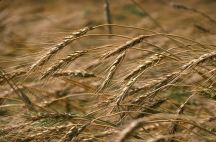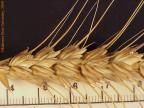Previous Page | Right click this page to print.
Wheat
In the U.S., wheat is primarily grown for human consumption. As a result of the demand in human food production, a very small portion of the total grain produced is fed to animals. In general, wheat fed to animals has been rejected by the human food industry and therefore becomes affordable for the animal feed industry. In more recent years, more animal feed varieties have been developed. Wheat grows in a wide range of geographical regions.
Figure 4.16 illustrates wheat in a field.

Estimated average yield of wheat grain is 40.2 bushels per acre.
Figure 4.17 illustrates wheat grain on the head.

Figure 4.18 illustrates wheat grain.

Table 4.6 summarizes the average nutrient composition of wheat.
Nutrient |
Average Composition
– (HW; SW) - % |
|---|---|
Crude protein |
14.2; 11.7 |
Ether extract |
1.7; 1.8 |
Crude fiber |
2.3; 2.1 |
Ash |
2.0; 1.8 |
NFE |
79.8; 82.6 |
Starch |
63.4; 67.2 |
The table presents information for both hard winter and soft white. As an energy source, the nutritional value of wheat is slightly lower than corn. As a protein source, compared to corn, wheat has both higher protein content and a better amino acid profile. Wheat is especially better in terms of lysine, tryptophan, methionine, cystine, and histidine. However, being a cereal grain, wheat remains deficient in lysine, threonine, and methionine. The protein content of wheat is similar to grains such as barley and oats. The amino acid profile is ranked below oats and barley. Wheat contains gluten proteins. Addition of moisture to gluten proteins, creates a sticky, viscous material. Therefore, wheat is often used in mills to aid in pelleting. The lipid content of wheat is relatively low. The lower essential fatty acid content, compared to corn, may influence the appearance but not the production of animals.
Wheat is classified by three characteristics. The first characteristic is kernel texture; classified as either hard or soft. Hard wheat has a higher protein content, a better amino acid profile, and a higher gluten content compared to soft wheat. The second characteristic is color; either white, red, or amber. Finally, the third characteristic is planting and growing season; either winter or spring. Winter wheat produces higher yields than spring wheat.
The most common factors influencing the feeding value of wheat are ergot and mycotoxins. Ergot will be discussed later in the module. In general, mycotoxins are not a problem. However, if wet wheat is allowed to lie in the field, mold and the subsequent toxins may reduce feeding value.
For most of the livestock species, wheat is a palatable feedstuff. An additional feeding characteristic of wheat is the rate of starch digestion. Wheat is the most rapidly digested of all the cereal grains. For this reason, consideration should be given to amount in the diet and processing method. Typically, wheat is processed to improve nutritional value. For poultry, wheat may be substituted for corn in the diet. For ruminants, wheat is added in limited amounts and used in combination with other grains to prevent nutritional disorders. Wheat is also fed to swine, both young and finishing.
Previous Page | Right click this page to print.